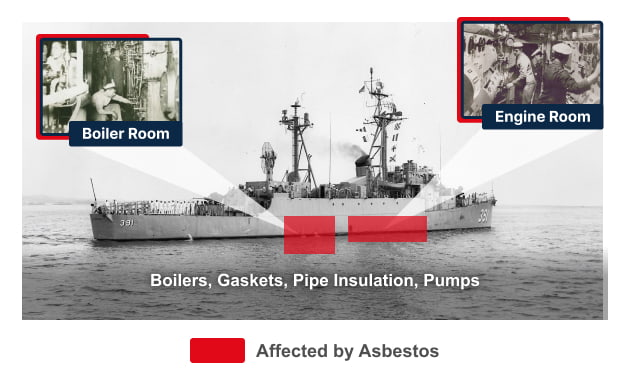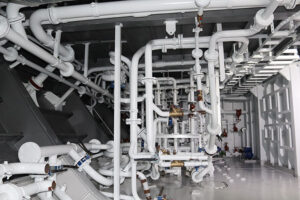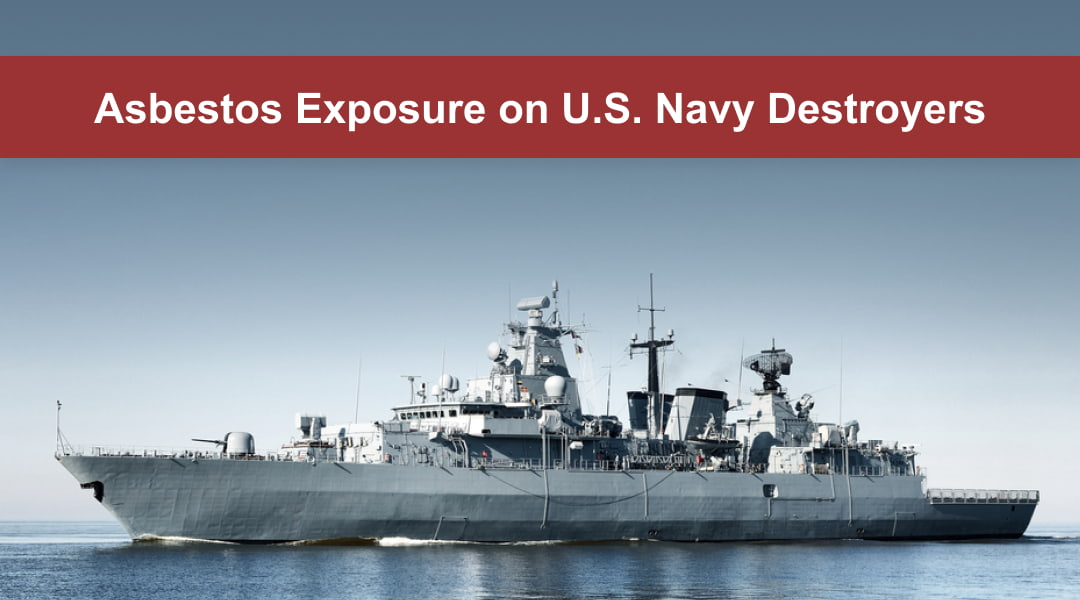Asbestos was everywhere on destroyer escorts, making it likely that U.S. Navy personnel inhaled contaminated dust even if they did not directly work with the substance. This exposure put many Navy veterans at risk of mesothelioma. Get help if you or a loved one now has mesothelioma after serving on a Navy destroyer escort.
Asbestos and Destroyer Escorts Explained
Destroyer escorts were a type of ship used mainly by the United States Navy in amphibious operations starting in World War II. They destroyed submarines and protected against attacks from aircraft carriers.
Video Summary: U.S. Navy destroyers relied on asbestos, the only known cause of mesothelioma, for decades. Navy veterans could be at risk of mesothelioma if they served on these ships. View Transcript
Between the 1930s and early 1980s, the United States Navy built nearly every destroyer with asbestos-based products. This meant that thousands of sailors and shipbuilders were exposed to this cancer-causing substance on a daily basis.
Navy destroyers relied on asbestos to keep boilers, pipes, turbines, and other parts well insulated and fire resistant.
However, Navy veterans that served on destroyers that used asbestos could develop deadly cancers like mesothelioma and lung cancer 10 to 50 years later. The risks of asbestos were hidden from the military and public for decades. Because of this, those who were exposed to asbestos on U.S. Navy destroyers may not have been aware of the danger they were facing.
If you or a loved one served on a U.S. Navy destroyer and have been diagnosed with mesothelioma, there is help available.
The U.S. Department of Veterans Affairs offers a wide range of benefits — including health care and monthly compensation — to veterans with mesothelioma. Our team can help you file a mesothelioma VA benefits claim now.
We can also connect you to top doctors, financial aid, and additional resources that can help you and your family.
The Mesothelioma Veterans Center stands ready to help if you developed mesothelioma from serving on destroyers or other Navy ships. Reach out to us today.
Unfortunately, over 500 Navy destroyer escorts built before the 1980s used asbestos-based products. Veterans who were exposed to asbestos on these vessels could be at risk of deadly cancers like mesothelioma later in life.
Thankfully, veterans with mesothelioma or other asbestos-related illnesses can pursue benefits from the U.S. Department of Veterans Affairs (VA). They can also seek payment from the makers of asbestos-based products and get medical care.
Get a Free Veterans Packet if you were exposed to asbestos on a destroyer escort and now have mesothelioma.
List of Destroyer Escorts With Asbestos
There were more than 500 Navy destroyer escorts that contained asbestos-based products. Anyone who served aboard these ships could now be at risk of mesothelioma.
These destroyer escorts included:
- USS Alger (DE 101)
- USS Amesbury (DE 66)
- USS Austin (DE 15)
- USS Barber (DE 161)
- USS Baron (DE 166)
- USS Bowen (DE 1079)
- USS Chambers (DE 391)
- USS Cockrill (DE 398)
- USS Crouter (DE 11)
- USS Daniel (DE 335)
- USS DeLong (DE 684)
- USS Dionne (DE 261)
- USS Donnell (DE 56)
- USS Edsall (DE 129)
- USS Eisele (DE 34)
- USS Evarts (DE 5)
- USS Finch (DE 328)
- USS French (DE 367)
- USS Garcia (DE 1040)
- USS Jobb (DE 707)
- USS Lockwood (DE 1064)
- USS Marsh (DE 699)
- USS McAnn (DE 73)
- USS Moore (DE 240)
- USS Oswald (DE 71)
- USS Slater (DE 766)
The list above is only a small sample of the destroyer escorts that used asbestos. Our team can determine if a ship you served on put you in danger of mesothelioma.
Which Asbestos Products Were Used on Destroyer Escorts?
Many asbestos-containing products were used on almost every Navy ship due to government mandates for decades.
This is because asbestos-based products helped keep vessels like destroyer escorts sturdy and the risks of asbestos exposure weren't publicly known until the early 1980s.


Notable asbestos-based products included:
Boilers
Boilers powered important machinery and destroyer escorts. But before 1973, manufacturers told the U.S. Navy that they had to use boilers coated with insulation containing roughly 15% asbestos.
Many boiler rooms on Naval ships were small and poorly ventilated. This meant asbestos fibers could be released into the air and easily ingested or inhaled by boiler tenders.
Testimonial“I was a boiler tender when I went aboard my first ship and started doing my first job. I asked them what material it was made out of, and they told me asbestos."
Gaskets
Boiler, valve, and pump gaskets aboard destroyer escorts may have contained asbestos, and working with or around them could put workers in danger.
For example, when installing valves, sailors had to disassemble older gaskets, replace them with new ones, and pack them with asbestos insulation. All of these activities could send asbestos flying.
Workers used wire brushes and scrapers to remove difficult gaskets, which may have released asbestos fibers into the air.
Pipe Insulation


When the pipe coatings on U.S. Naval vessels were damaged, the sailors had to remove and replace them.
This process involved mixing water with dry asbestos, causing fibers to be released into the air.
Pumps
Mechanical pumps that powered bilge, cooling, and heating systems on destroyer escorts were often insulated with asbestos.
It was the machinist’s mates who maintained these pumps and were exposed to asbestos during pump repairs.
Contact us if you worked around any asbestos-based products on a destroyer escort and later got sick. Compensation may be available.
Valves
Valves on destroyer escorts helped to control the flow of gasses and liquids throughout its pipes.
Asbestos helped the valves withstand the high pressures and chemical gasses used in pipes on the ship, but it also put those on board at risk of mesothelioma later in life.
Other Products Containing Asbestos on Destroyer Escorts
- Adhesives
- Aggregate mixtures
- Bedding compounds
- Block insulation
- Capacitors
- Deck covering materials
- Grinders
- Hydraulic assemblies
- Packing materials
- Paneling
- Thermal materials
- Tubes
- Turbines
U.S. Navy personnel serving on destroyer escorts might not have worn protective gear when working around the asbestos-containing products listed above, as the risks weren't fully known for decades on end.
We can help eligible Navy veterans with mesothelioma access VA benefits, treatments, and compensation. Get started by ordering a Free Veterans Packet.
High-Risk Asbestos Jobs on Destroyer Escorts
Some U.S. Navy veterans who served aboard destroyer escorts were at a higher risk of asbestos exposure than others, depending on what job they held.
Asbestos exposure was common among boiler operators, pipe fitters, and engine room workers. These workers often had to repair or replace asbestos-containing parts in poorly ventilated spaces.
Other destroyer escort jobs with a risk of exposure included:
- Electricians
- Insulators
- Kitchen staff
- Machinists
- Mechanics
- Medical officers
- Pipefitters
- Plumbers
- Shipbuilders
- Shipyard workers
Sadly, asbestos-related diseases like mesothelioma, lung cancer, or asbestosis can take up to 50 years to appear. That’s why many U.S. Navy veterans who served on destroyer escorts and other amphibious warships are just now getting sick.
Compensation Options for Veterans With Mesothelioma
If you served on a U.S. Navy destroyer escort proven to contain asbestos and are now facing a mesothelioma diagnosis, you have options to seek compensation.
Compensation for a service-related mesothelioma diagnosis can help cover your medical bills, the pain you’ve endured, and more. Learn how to get compensation below.
VA Benefits
The U.S. Department of Veterans Affairs (VA) offers a wide range of benefits to veterans with mesothelioma.
Mesothelioma VA benefits include monthly payouts worth almost $4,000 in most cases and treatment from top doctors through VA health care. File for mesothelioma VA benefits now.
Mesothelioma Lawsuits
You or a loved one may be able to file a mesothelioma lawsuit to get compensation from manufacturers of asbestos-containing products, with no action taken against the U.S. military. These lawsuits award $1 million on average.
Lawsuits for asbestos exposure on destroyer escorts have paid out:
- $3.78 million to a Navy veteran from Pennsylvania Navy veteran after serving on the USS Lloyd S. Carlson and USS David Stone
- $2.29 million for a veteran who served on the USS Lake Champlain as a machinist mate
- $2 million for a North Carolina boilerman who was exposed to asbestos in the U.S. Naval Training Center, the USS Bryce Canyon, and USS Stein
- $1.93 million for a Pennsylvania Navy gunner who was aboard the USS Lou Gehrig, USS James Marshall, and USS Daniel H. Hill
- $1.92 million for a U.S. Navy fireman with pleural mesothelioma from serving on the USS George W. Ingram
Filing a mesothelioma claim won't impact your ability to get VA benefits.
Call our team at (877) 450-8973 to get help filing a claim.
Asbestos Trust Fund Claims
Many companies that made asbestos products used on Navy destroyer escorts filed for bankruptcy. In the process, they were forced to set aside trust funds to compensate victims.
Asbestos trust funds contain more than $30 billion today. You may qualify to file a claim with multiple trusts and get compensation.
Help After Asbestos Exposure on Destroyer Escorts
U.S. veterans who were exposed to asbestos on destroyer escorts are at a very high risk of mesothelioma today.
Thankfully, it's possible to get financial aid, medical care, and VA benefits after a mesothelioma diagnosis.
The Mesothelioma Veterans Center has fellow U.S. veterans, VA-accredited staff, and patient advocates on hand to help veterans with mesothelioma and their loved ones.
Get a Free Veterans Packet to learn how you can access VA benefits and compensation now.
Asbestos on Destroyer Escorts FAQs
Which U.S. Navy ships had asbestos?
Over 500 destroyer escorts were built with asbestos-containing materials, putting anyone who served aboard these vessels at risk of mesothelioma later in life.
Further, nearly every U.S. Navy vessel contained asbestos due to government mandates prior to the 1980s.
Is asbestos still used on ships?
No. As of 2024, only one U.S. Navy destroyer escorted from World War II remains afloat: the USS Slater.
The USS Slater was built with asbestos, but the vessel underwent a major renovation in 2019 to remove this toxic substance.
Where was asbestos found on destroyer escorts?
Asbestos could be found throughout U.S. Navy destroyer escorts, including boilers, valves, pumps, and insulation.
Any military service member who worked with or around these materials was at risk of inhaling asbestos fibers and developing mesothelioma later in life.
Can you sue the Navy for asbestos exposure?
You cannot sue the U.S. Navy for asbestos-related diseases like mesothelioma, but you can file for VA benefits to get monthly compensation and free or low-cost medical treatments.
Further, you can sue the private companies that made and sold asbestos-containing materials to the military.
Contact us for help filing for VA benefits or securing compensation through a lawsuit.



